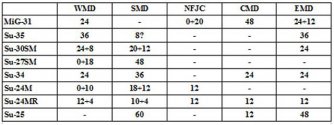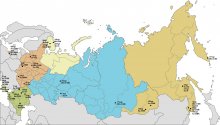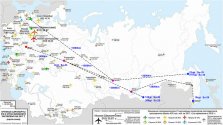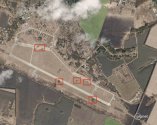... that
Russia doesn't understand air power and as a result it doesn't have the necessary resources and skills to conduct air operations on a level that is appropriate to this campaign. So they keep quiet and hope nobody realizes that they were all of them deceived for another ring was made and it cost all of the money for training and munitions.
Soviet Union ended 30 years ago. Russian Air Force is a solution to a political problem - not a tool for military strategy. RuAF commanders know that:
- their air force is mostly a bluff
- they are already taking problematic losses
- if they attempted to fight a proper air campaign - for which they are not prepared and have not received training - the losses would quickly become unsustainable
The losses don't have to come from the enemy. There's a reason why e.g. Desert Storm air campaign lasted five weeks but not six or seven.
It takes a machine effort to fly and there's a point at which planes simply fall out of the sky. Air forces know how to maintain optempo and when to quit.
Calculate like this:
After close to
four months of combat operations (15 weeks = 3x Desert Storm) number of confirmed losses (destroyed/heavily damaged) to aircraft lost to excessive combat use (requiring overhaul) is
at minimum 1:2. So if RuAF already lost 10 Su-34s it lost 20 Su-34s from excessive use. If it lost 13 Su-25s it temporarily lost another 26 Su-25s. If it lost 5 Su-30s it lost 10 more etc. Those are not aircraft which are in regular maintenance that takes a bit longer because of high optempo. They need total overhaul because they were used so much. The rest is available at the usual 60-70% mission capable rate.
I attached aircraft numbers so you can recalculate how many are available - especially including geographical split - after glorious liberation of 20% of a almost-failed state with no economy. Peter I is bursting with pride so much his tomb could power all of Sankt Petersburg.
People who imagine themselves knowledgeable might disagree and point to the fact that Russia has approximately four hundred new 4,5-gen fighters (Su-30SM, Su-35S, Su-34) delivered after 2010 and that should solve everything but there are many factors which enable effective use of this potential (like funding for training of crews which for years has been at very low level, but on which I have little hard data) including
three crucial bottlenecks which play a particularly important role in Ukraine:
1. Situational awareness on the ground and at low altitudes within enemy territory
Russia has only
nine AWACS aircraft (3 A-50 and 6 modernized A-50U). Initially they operated them in Belarus but now they have shifted to Crimea after loss of Moskva. If two A-50s are on constant patrol that's the entire AWACS fleet that RuAF has available. A-50 is also not a modern system - it's Soviet technology from the 80s. It's worse than old E-3. A-100 is in development and just one airframe has been built for testing.
To that Russia can add only about 20 obsolete Il-20s performing ELINT but these aircraft are in no way sufficient to provide the necessary information in real time. There are only
two new Tu-204 ELINT platforms in service. That means Russia is flying with data late by several hours
at best and once they're in the air their ability to adapt to a change in tactical situation is limited.
Russia has to fly around on the battlefield using either passive detection or active radar to find targets. Passive detection requires dedicated aircraft flying with pods but they are susceptible to deception - aircraft can be forced to reveal their position just like air defenses. Ukraine can operate an active radar on a Osa launcher, while Buk can wait in ambush. When using active radar the aircraft are subject to inverse square law meaning that they reveal themselves before they detect their targets so it is only a viable tactic outside of NATO detection zone which covers most of western and southern Ukraine. But even then it is not viable for any prolonged period of time because it requires a lot of
moving around in the bushes with the searchlight which they
can't afford. So they're entirely reliant on what their satellite or ground force recon provides.
2. Aerial refueling
Russia has only
eighteen aerial refueling aircraft but since Il-78s are subordinate to Long Range Aviation they nominally support strategic bombers.
Su-30s and Su-35s can't carry spare tanks which leaves only Su-34 for long range missions.
Anyone who has ever seen tables for mission planning knows just
how much fuel is burnt during
any maneuvering even excluding combat. There's a reason why during Desert Storm F-15C flew with four AIM-7Ms and three spare tanks and did not engage until a patrolling AWACS called for it. Just staying in the air is
expensive. Moving around? You can't afford it. So you don't do it unless you have to. That's the reality of air combat that is not shown in video games or movies or agitprop online. Air combat is take off, fly for a while, shoot your ordnance, hopefully don't get shot at, come back. It's very short and constrained.
3. Geographical distribution
Russia has split its air force between the military districts attempting to create strategic joint commands. This is the approximate composition of each military district - first figure is RuAF, second is Naval Aviation. It doesn't include bombers.
View attachment 90521
MiG-31s can be disregarded as they are useless in the current conflict and Su-27s are not equipped with systems for proper anti-surface warfare.
You can use my thread on Desert Storm Air Campaign if you want hard data on how numbers translate into results:
The following is a collection of maps, tables and quotations from publicly available sources with heavy emphasis on Government Accountability Office's report "Operation Desert Storm - Evaluation of the Air Campaign". I divided the whole set into five posts: air superiority over Iraq -...
www.sinodefenceforum.com
The table above does not reflect availability of sufficiently trained crews and readiness of aircraft. Remember that it takes between 2 and 4 years to train a combat pilot in peacetime, and RuAF training was pathologically underfunded. Make your calculations based on dates of delivery of new aircraft as indicated in table below (MiG-29s are withdrawn):
View attachment 90522
This is the location of the units - the map has one or two minor errors but they are not relevant for the subject which is the geographical scale and separating distances.
View attachment 90520
In particular the Eastern MD is a logistical burden. Here's an example of what routes units from EMD have to take to reinforce RuAF in Ukraine. Consider that aerial refueling is an essential part of such operations both for fighters and transport planes carrying other materials.
View attachment 90519
Air combat doesn't have frontlines but it does have boundaries. There's a point at which no amount of Zircons in the world can prevent your opponent from flying an air wing over international waters in a show of force next to one such boundary and if you have nothing to counter it without starting a major conflict you effectively lose without firing a shot.
This is why those numbers and maps matter and why the margins for acceptable losses in RuAF are microscopic.
And as for effectiveness missile strikes - this is Ukrainian air base at Ozerne from earlier in the conflict:
View attachment 90524
It definitely doesn't count as a successful military operation but it could work as modern avant-garde art. You know, the kind that forces you to challenge your preconceptions of what art should be and what it should
aim for.
Don't worry. It's only factual data. You are free to ignore it and return to more winning. I heard Russia just captured the town of Veliky Mukhosransk on Seversky Pizdyets from three and a half nazis and their dog. How can they not be tired from so much winning?!





